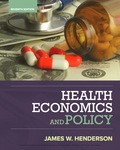A. Compute the competitive market price and quantity outcome under the usual assumptions. B. Compute the welfare loss from adverse selection in this competitive market. Also, compute the number of people who should have insurance from a social perspective. Remember that some people here may not have positive social value of insurance, so shouldn't be counted in the deadweight loss from adverse selection. This could be because, e.g. there are administrative costs of providing insurance. C. Now, assume that the regulator implements a mandate that requires everybody to buy insurance in the market. Assume the mandate is completely effective, and that everyone gets insurance. What is the welfare impact of this mandate? Is it larger or smaller in absolute value (magnitude) than the welfare loss from adverse selection calculated in B? Is it negative or positive? D. Now, assume that the regulator would like to implement this mandate buy legally isn't required to force people to purchase insurance. However, the regulator decides to try and get people to buy insurance by subsidizing them to buy insurance. Assume that the regulator gives all consumer a subsidy equal to 2, funded from general taxation revenues. Given this subsidy, how many people buy insurance now in this competitive market? What is the price of insurance (before factoring the subsidy into that price)?
A. Compute the competitive market price and quantity outcome under the usual assumptions. B. Compute the welfare loss from adverse selection in this competitive market. Also, compute the number of people who should have insurance from a social perspective. Remember that some people here may not have positive social value of insurance, so shouldn't be counted in the deadweight loss from adverse selection. This could be because, e.g. there are administrative costs of providing insurance. C. Now, assume that the regulator implements a mandate that requires everybody to buy insurance in the market. Assume the mandate is completely effective, and that everyone gets insurance. What is the welfare impact of this mandate? Is it larger or smaller in absolute value (magnitude) than the welfare loss from adverse selection calculated in B? Is it negative or positive? D. Now, assume that the regulator would like to implement this mandate buy legally isn't required to force people to purchase insurance. However, the regulator decides to try and get people to buy insurance by subsidizing them to buy insurance. Assume that the regulator gives all consumer a subsidy equal to 2, funded from general taxation revenues. Given this subsidy, how many people buy insurance now in this competitive market? What is the price of insurance (before factoring the subsidy into that price)?
Chapter9: The Physicians’ Services Market
Section: Chapter Questions
Problem 1QAP
Related questions
Question

Transcribed Image Text:Consider the case of a competitive health insurance market, similar to what we studied in the
graphical framework in Week 4A. Assume that, as in the Affordable Care Act, the government
allows many insurers to compete (perfect competition) to offer the one kind of insurance contract
allowed (this is just the same as the framework we’ve discussed all along, starting in Week 4A).
Consumer demand for insurance is described by:
P = 15 - .7 Q
Qmax = 20
Assume that marginal and average costs are characterized by:
MC= 10 – 4Q
AC= 10 - .2Q
A. Compute the competitive market price and quantity outcome under the usual assumptions.
B. Compute the welfare loss from adverse selection in this competitive market. Also, compute
the number of people who should have insurance from a social perspective. Remember that
some people here may not have positive social value of insurance, so shouldn't be counted
in the deadweight loss from adverse selection. This could be because, e.g. there are
administrative costs of providing insurance.
C. Now, assume that the regulator implements a mandate that requires everybody to buy
insurance in the market. Assume the mandate is completely effective, and that everyone gets
insurance. What is the welfare impact of this mandate? Is it larger or smaller in absolute
value (magnitude) than the welfare loss from adverse selection calculated in B? Is it negative
or positive?
D. Now, assume that the regulator would like to implement this mandate buy legally isn't
required to force people to purchase insurance. However, the regulator decides to try and get
people to buy insurance by subsidizing them to buy insurance. Assume that the regulator
gives all consumer a subsidy equal to 2, funded from general taxation revenues. Given this
subsidy, how many people buy insurance now in this competitive market? What is the price
of insurance (before factoring the subsidy into that price)?
Expert Solution
This question has been solved!
Explore an expertly crafted, step-by-step solution for a thorough understanding of key concepts.
This is a popular solution!
Step 1: Terms and Information given
VIEWStep 2: Answer to A. Compute the competitive market price and quantity outcome under the usual assumptions.
VIEWStep 3: Answer to B. Compute the welfare loss from adverse selection in this competitive market.
VIEWStep 4: Answer to C. What is the welfare impact of this mandate?
VIEWStep 5: Answer to D. The number of people who buy Insurance in competitive market and price of Insurance ?
VIEWSolution
VIEWTrending now
This is a popular solution!
Step by step
Solved in 6 steps

Knowledge Booster
Learn more about
Need a deep-dive on the concept behind this application? Look no further. Learn more about this topic, economics and related others by exploring similar questions and additional content below.Recommended textbooks for you


Economics (MindTap Course List)
Economics
ISBN:
9781337617383
Author:
Roger A. Arnold
Publisher:
Cengage Learning



Economics (MindTap Course List)
Economics
ISBN:
9781337617383
Author:
Roger A. Arnold
Publisher:
Cengage Learning




Microeconomics: Private and Public Choice (MindTa…
Economics
ISBN:
9781305506893
Author:
James D. Gwartney, Richard L. Stroup, Russell S. Sobel, David A. Macpherson
Publisher:
Cengage Learning